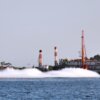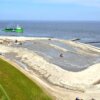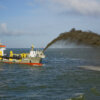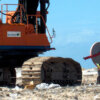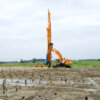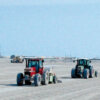Explosive Compaction (EC) involves placing a charge at depth in a borehole in loose soil and then detonating the charge.
It is generally used in sands to silty sands or sands and gravels. Several charges are fired at one time, with delays between each charge to enhance cyclic loading while minimising peak acceleration.
Suitability of Explosive Compaction
Often several charges will be stacked in one borehole with gravel stemming between each charge to prevent sympathetic detonation. Although not that often used in land reclamation projects, Explosive Compaction can be attractive, as explosives are an inexpensive source of readily transported energy and allow densification with substantial savings over alternative methods.
Only small-scale equipment is needed (for instance, geotechnical drill or wash boring rigs), minimising mobilisation costs and allowing work in confined conditions. Compaction can be carried out at depths beyond the reach of conventional ground treatment equipment. Most explosive compaction has been driven by concerns over liquefaction, and has been on loose soils below the water table to depths of nearly 50 metres.
Empirical trials
As with many other geotechnical processes, explosive compaction has been designed largely on experience rather than theory. It is common to carry out a trial before starting full-scale treatment. This empirical design basis appears to be an obstacle to the widespread use of an otherwise inexpensive and effective compaction method: owner’s review boards are often reticent in approving proposals, contractors are unsure of risk factors when bidding work, and consulting geotechnical engineers lack familiarity with the method.
Following detonation of the charges, some immediate ground heave or small settlements occurs around individual blast holes. Nothing is then apparent at ground surface for at least several minutes or, in the case of fine sand, tens of minutes; then the ground starts to settle, and continues to settle for upwards of an hour. Compaction induced by explosives is not over the few seconds of explosive detonation but is rather an induced consolidation over several hours, even with sandy gravels. Explosives generate residual excess pore water pressure that dissipates and results in consolidation related compaction.
Time dependence of blasts
Penetration resistance of the compacted sands shows pronounced time dependence. Some case histories show no increase or even a decrease in penetration resistance immediately after blasting, while other case histories show only a modest increase in resistance. However, the penetration resistance two weeks after blasting is often double the pre-compaction value. Delayed strength gain must be allowed for in developing an explosive compaction.
Controlling impacts on nearby structures
Induced vibrations on nearby structures need to be controlled where blast densification is carried out in developed areas. Blasting within 30-40 metres of existing structures requires a reduction in the charge weights per deck (involving a reduction in blast hole spacings) and in the number of holes detonated at any one time. Also, when blasting is carried out on or adjacent to slopes, blast patterns are adjusted to restrict the zone of residual pore water pressure build-up and minimise the risk of slope instability.
Design of charge delays
Design of the appropriate charge delays between adjacent decks in each borehole and between adjacent boreholes is carried out using the following process:
a. Ground vibration patterns (peak particle velocities and frequency content) are determined at a particular location of concern, remote from the blast point due to a single charge. This is best done using field measurements.
b. The frequency range of potentially damaging vibrations is selected based on structural vibration theory or other considerations.
c. The effects of sequential charge detonation from a decked array of boreholes are assessed by a simple linear combination of the single charge wave trains in which time delays between decks and between adjacent boreholes are varied. Optimum blast delays are then determined to minimise the peak particle velocity or, alternatively, the vibrational energy content in the frequency range of interest.




